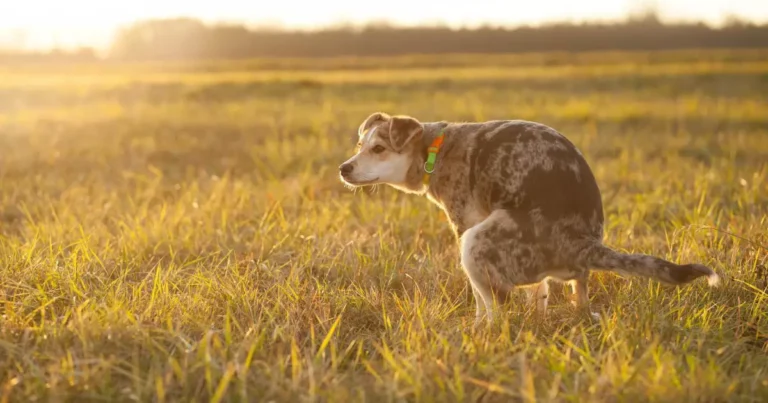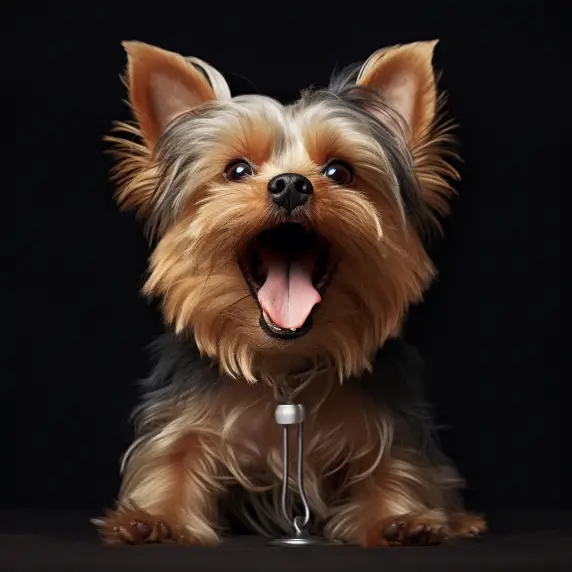Why Do Dogs Have Bald Bellies? Answers Revealed 🐶
Is your dog’s belly looking a bit bare? You’re not alone! Many dog owners wonder why their pets have bald bellies. This blog post delves into the reasons behind this phenomenon and offers helpful advice on prevention and treatment. Let’s get started!
Key takeaways
Some dogs have naturally thin fur on their bellies.
Bald bellies can be caused by various factors, such as allergies, hormonal imbalances, and parasites.
Treatment depends on the underlying cause, and prevention is key.
4 Common Causes of Bald Bellies in Dogs
There are several reasons your dog may be experiencing hair loss on their belly. Understanding these common causes can help you determine the best course of action for treatment and prevention.
1) Allergies
Allergies are a common cause of bald bellies in dogs. These can include contact allergies (such as reactions to certain fabrics or chemicals), environmental allergies (like pollen or mold), and food allergies.
Symptoms often include itching, redness, and hair loss on the belly and other areas of the body. To treat allergies, it’s crucial to identify and eliminate the allergens. Your vet may also recommend medications such as antihistamines or corticosteroids to help manage the symptoms.
2) Hormonal Imbalances
Hormonal imbalances can lead to hair loss on your dog’s belly and other areas. Conditions like hypothyroidism or Cushing’s disease can disrupt your dog’s hormone levels, causing symptoms such as hair loss, weight gain, and lethargy.
Treatment for these conditions typically involves medication or hormone therapy to restore balance and encourage hair regrowth.
3) Parasites
Parasites like fleas, mites, and ticks can cause irritation and hair loss on your dog’s belly. These parasites can lead to excessive itching, which may result in your dog scratching or biting their skin, causing hair loss.
Treatment for parasites usually involves parasite prevention measures, such as flea and tick collars or monthly topical or oral medications. If your dog already has an infestation, your vet will recommend an appropriate treatment to eliminate the parasites.
4) Pressure Sores and Over-Grooming
Pressure sores can develop on your dog’s belly if they frequently lie on hard surfaces, resulting in hair loss and skin irritation. Providing your dog with comfortable bedding can help prevent these sores and promote healthy hair growth.
Over-grooming is another potential cause of bald bellies in dogs. This behavior can be triggered by stress or boredom, leading your dog to lick or chew their belly excessively, causing hair loss.
Addressing the underlying causes of stress and boredom, such as providing more exercise or mental stimulation, can help reduce over-grooming and promote hair regrowth. If the problem persists, consult your vet for further evaluation and recommendations.
The Normal Belly: Thin Hair and Breed Differences
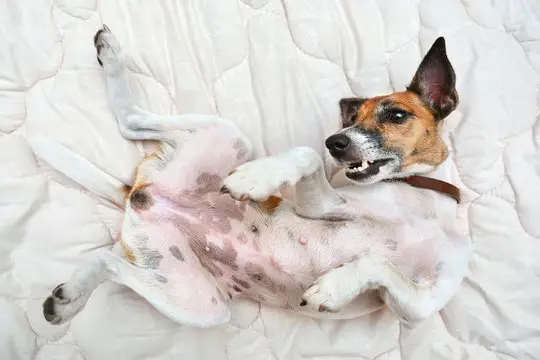
Before jumping to conclusions about your dog’s bald belly, it’s important to understand that some dogs naturally have thinner fur on their bellies. This is not a cause for concern and simply reflects the variations in fur thickness among different breeds.
Here’s what you should know about the normal belly, thin hair, and breed differences.
Naturally Thin Fur
Many dog breeds have naturally thinner fur on their bellies compared to the rest of their bodies. This is particularly true for breeds with shorter coats. The thin fur serves a purpose, as it helps dogs regulate their body temperature more efficiently by allowing heat to dissipate quickly.
So, don’t be alarmed if your dog’s belly appears to have less hair than other areas.
Breed Variations
Different dog breeds have distinct fur types, thicknesses, and growth patterns. Some breeds, like Greyhounds, Whippets, Boxers, and Jack Russell Terriers tend to have thinner fur on their bellies, while other breeds, such as German Shepherds or Golden Retrievers, may have thicker fur in this area.
Understanding your dog’s breed characteristics can help you determine if their bald belly is normal or if there might be an underlying issue causing hair loss.
Distinguishing Natural Thin Fur from Hair Loss
It’s essential to differentiate between your dog’s natural belly fur and hair loss caused by an underlying condition. Natural thin fur will have a consistent appearance without signs of inflammation, redness, or irritation.
On the other hand, hair loss due to an underlying issue may be accompanied by symptoms such as itching, skin irritation, or patchiness. If you’re unsure whether your dog’s bald belly is natural or due to an issue, consult your veterinarian for an evaluation and advice.
Diagnosis and Treatment: When to See a Vet
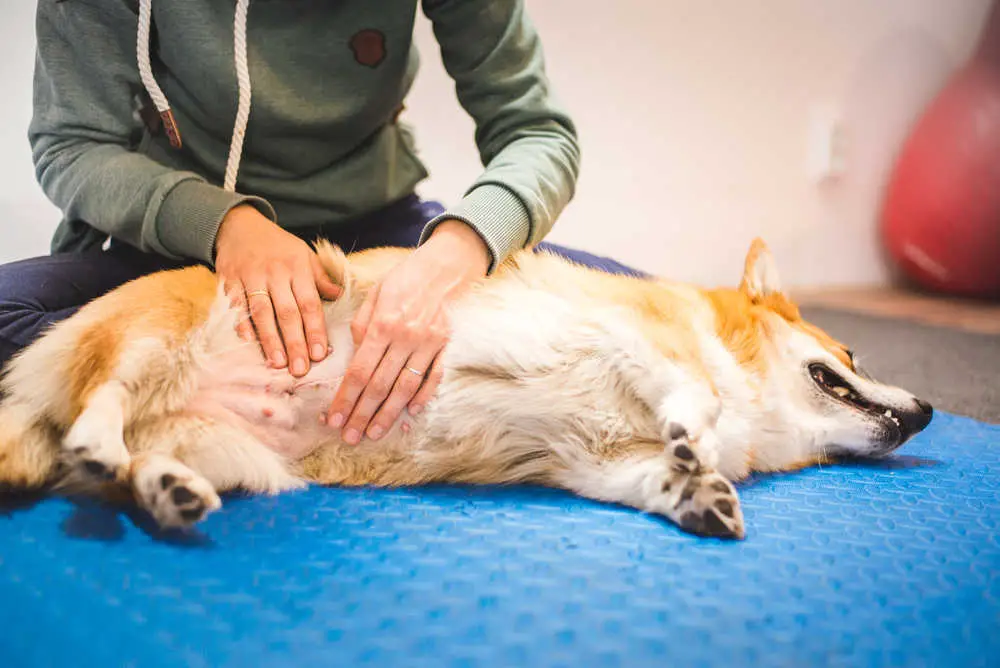
If you suspect that your dog’s bald belly is not due to natural thin fur or breed differences, it’s essential to consult your veterinarian for a proper diagnosis and treatment plan. Here’s what to expect when seeking professional help for your dog’s hair loss.
Importance of a Proper Diagnosis
A proper diagnosis is crucial in determining the underlying cause of your dog’s bald belly and ensuring that they receive the appropriate treatment. Hair loss can be caused by various factors, as discussed earlier, and each cause requires a different treatment approach.
Attempting to treat your dog without a proper diagnosis could lead to ineffective treatment or even exacerbate the issue.
Diagnostic Tests
Your veterinarian will conduct a thorough examination of your dog and may perform several diagnostic tests to identify the cause of their hair loss. These tests may include:
- Blood tests: To check for hormonal imbalances, infections, or other systemic issues.
- Skin scrapings: To check for parasites, bacterial infections, or fungal infections.
- Allergy testing: To identify potential allergens that could be causing your dog’s hair loss.
Depending on the results, your vet may recommend additional tests to confirm the diagnosis and rule out other possible causes.
Customized Treatment Plans
Once your veterinarian has determined the cause of your dog’s bald belly, they will develop a customized treatment plan tailored to your dog’s specific needs. This plan may include medications, lifestyle changes, or dietary adjustments, depending on the underlying cause.
For example, if your dog’s hair loss is due to allergies, the treatment plan may involve eliminating the allergen from their environment, prescribing antihistamines or corticosteroids, and implementing a hypoallergenic diet.
If parasites are the cause, your vet may recommend parasite prevention measures and prescribe medication to eliminate the infestation.
It’s crucial to follow your vet’s treatment plan closely and keep them informed of your dog’s progress. If your dog doesn’t respond to the initial treatment or if new symptoms arise, your vet may need to adjust the treatment plan accordingly.
Prevention Tips
While some causes of bald bellies in dogs may be unavoidable, there are several steps you can take to prevent hair loss and keep your dog’s skin and fur in good condition. Following these prevention tips can help maintain your dog’s overall health and well-being.
Regular Grooming and Parasite Prevention
Regular grooming is essential for keeping your dog’s coat healthy and free from tangles, which can lead to hair loss. Brushing your dog’s fur helps remove loose hair, stimulates hair growth, and distributes natural oils that nourish the skin.
Ensure you’re using appropriate grooming tools and techniques for your dog’s specific coat type.
Parasite prevention is also crucial in avoiding hair loss caused by fleas, ticks, or mites. Speak with your veterinarian about the best parasite prevention measures for your dog, such as monthly topical treatments, oral medications, or flea and tick collars.
Monitoring for Signs of Allergies or Hormonal Imbalances
Keep an eye out for signs that your dog may be experiencing allergies or hormonal imbalances, as these can lead to hair loss. Symptoms to look for include excessive scratching, redness, swelling, or changes in appetite, energy levels, and weight.
If you notice any of these signs, consult your veterinarian for an evaluation and recommendations on how to address the issue.
Providing Comfortable Bedding and Reducing Stress
Pressure sores can develop on your dog’s belly if they frequently lie on hard surfaces, leading to hair loss and skin irritation. Ensure your dog has a comfortable and supportive bed to prevent pressure sores and promote healthy hair growth.
Stress and boredom can also contribute to hair loss, as they can trigger over-grooming behaviors. Provide your dog with plenty of physical and mental stimulation, such as regular exercise, playtime, and puzzle toys, to help reduce stress and prevent over-grooming.
If you suspect that stress is the primary cause of your dog’s hair loss, consider consulting with a professional dog trainer or behaviorist for additional guidance and support.
Frequently Asked Questions
Can I use over-the-counter treatments for my dog’s bald belly?
While some over-the-counter treatments can provide temporary relief, it’s essential to consult with your veterinarian to determine the underlying cause and receive proper treatment.
Does my dog’s diet affect its bald belly?
Yes, dietary deficiencies or imbalances can contribute to hair loss. Consult with your vet to ensure your dog’s diet is meeting its nutritional needs.
Is hair loss on other parts of my dog’s body related to its bald belly?
It’s possible. If your dog is experiencing hair loss in multiple areas, it may be a sign of a more systemic issue, and it’s essential to consult your veterinarian for a thorough evaluation.
Can I use human hair growth products on my dog’s bald belly?
No, using human hair growth products on your dog may cause further irritation or adverse reactions. Always consult your veterinarian for appropriate treatments.
Will my dog’s bald belly grow hair back after treatment?
In most cases, hair will regrow after the underlying cause has been treated. However, the duration and success of hair regrowth may vary depending on the cause and individual dog.
Conclusion
Understanding the reasons behind your dog’s bald belly is essential in providing the proper care and treatment they need. While some dogs naturally have thin fur on their bellies, it’s important to be aware of potential underlying causes, such as allergies, hormonal imbalances, and parasites.
Regular grooming, parasite prevention, and monitoring for signs of issues can help prevent hair loss and keep your dog’s skin and fur healthy. Remember, always consult your veterinarian if you’re concerned about your dog’s hair loss or if you notice any unusual symptoms.
With the right care and attention, your furry friend can enjoy a healthy, comfortable life.

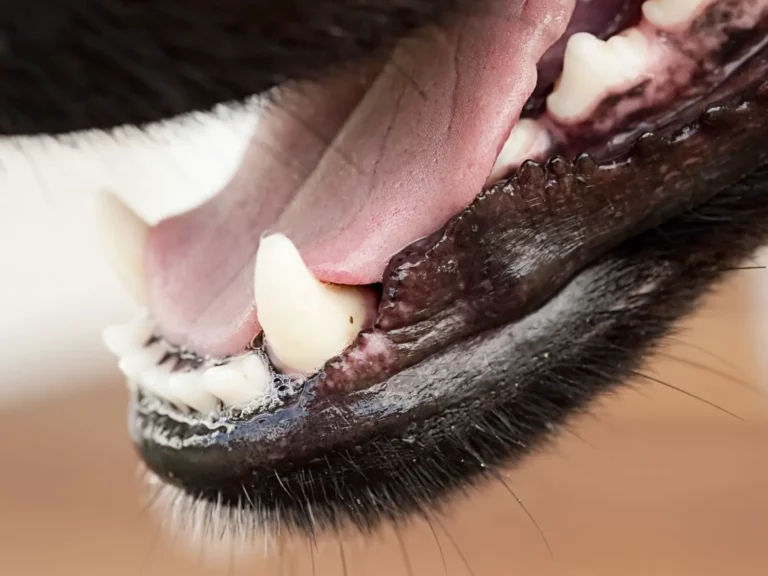
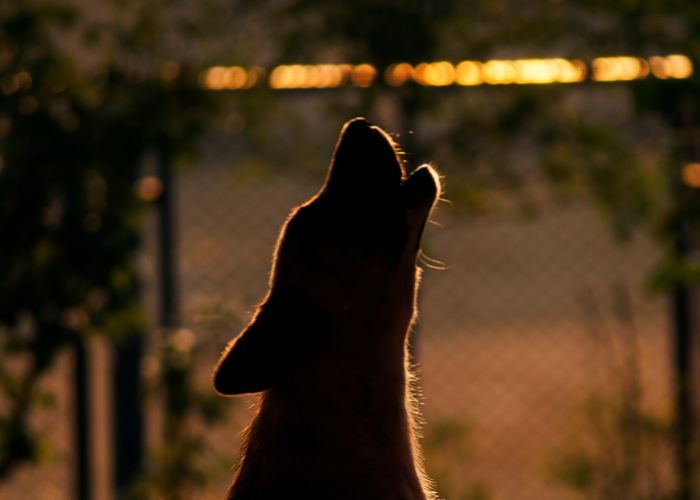

![Poisoning in Dogs Symptoms [5 Signs Your Dog Has Poisoning]](https://www.warmlypet.com/wp-content/uploads/2022/12/poisoning-in-dogs-symptoms-768x512.webp)
